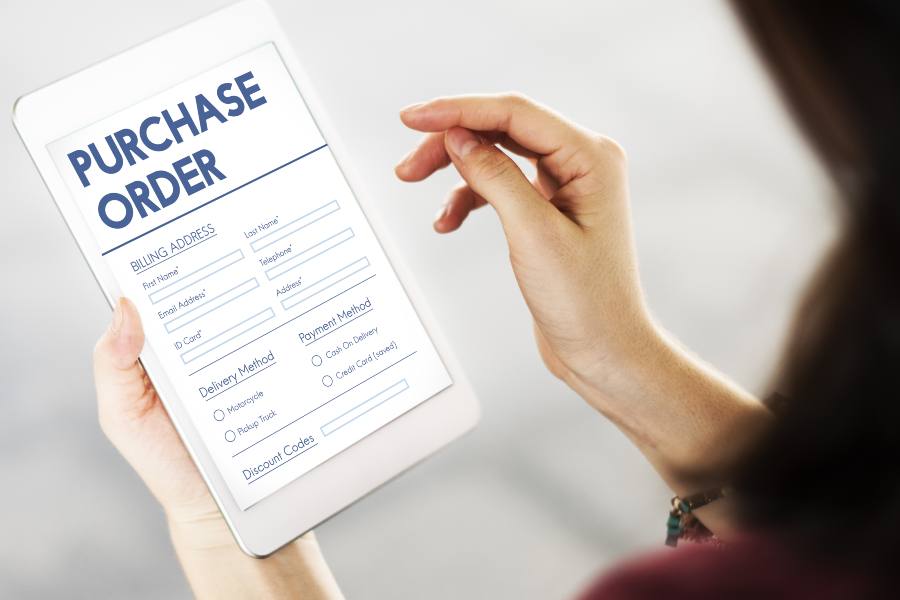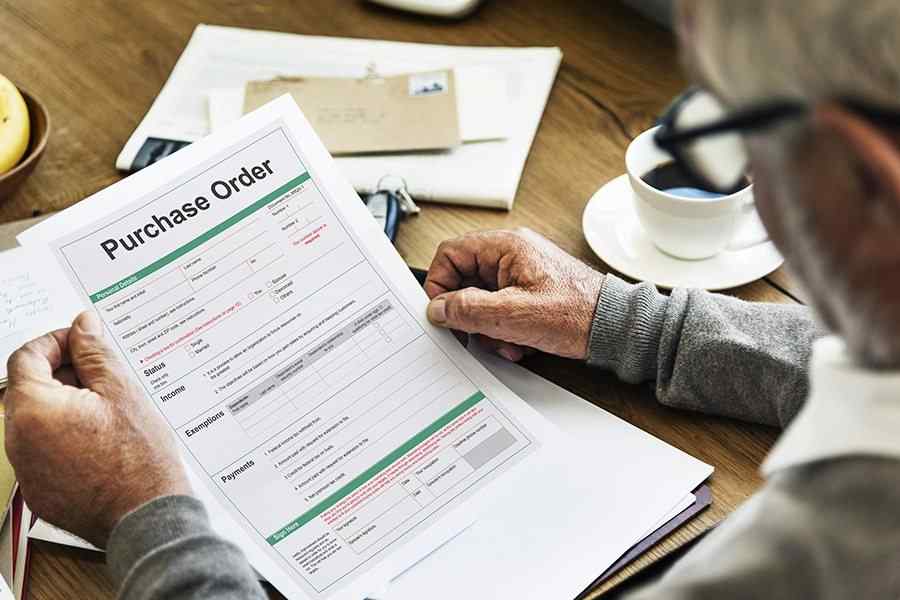A purchase order (PO) number is a unique identifier assigned to a PO document This document outlines a buyer’s intent to purchase goods or services from a particular vendor, detailing the specific items being ordered, quantities, and agreed-upon prices. . It simplifies tracking the PO throughout the process, from creation to fulfillment, for both the buyer and seller. Also, it aids in recordkeeping for accounting and auditing purposes. By referencing the PO number on communications, invoices, and other documents, you can ensure everyone involved is on the same page about a specific order.
Key Components of a Purchase Order Number
The key components of a PO number can vary depending on the specific formatting system a company uses. The PO number should be unique and provide a way to track and reference the PO it identifies.
The specific components used will depend on the level of detail a company requires, but there are three common elements found in many PO numbering systems.
- Identifier prefix: This helps categorize the order or indicate the department responsible for it. It is often short and can be letters, numbers, or a combination of both. Here are some examples:
- “PO”: Is a generic prefix signifying a PO
- “ENG-PO”: Identifies the engineering department’s PO
- Sequential number: This is a unique number assigned to distinguish each PO from others. It ensures chronological order within the numbering system and can be either a simple numeric sequence, such as PO1234, or an alphanumeric sequence, such as PO-ABC123.
- Date: The date the PO was created could also be included, such as PO20240416-123.
Some companies incorporate additional elements into their PO numbers to provide further information.
- Department code: This is a more specific code representing the department, such as ENG-PO-0416-123.
- Project code: This indicates if the PO relates to a specific project, such as PO-ABC-123-PRJ12.

Sample Purchase Order
Related resources:
Why Is a Purchase Order Number Important?
A PO number is a fundamental tool for bringing organization and clarity to the purchasing process. It benefits both buyers and sellers by offering the following:
- Enhanced tracking: PO numbers act as unique identifiers, allowing both the buyer and seller to track the progress of an order throughout its lifecycle. This means you can monitor everything from when a PO is issued to when the invoice is received and payment is made.
- Efficient recordkeeping: A PO number serves as an essential element in maintaining accurate records for accounting and auditing purposes. It simplifies finding past purchases and enables easy retrieval of order details whenever needed.
- Reduced errors: PO numbers help prevent errors by ensuring accurate referencing of specific orders. This minimizes the risk of mistakes like duplicate payments or processing the wrong order.
- Improved inventory management: For buyers, a PO number can aid in managing inventory levels. By tracking outstanding POs, you can anticipate incoming goods and avoid overstocking or understocking.
- Legal documentation: In some cases, PO numbers can serve as part of a legally binding contract, especially once a supplier accepts the terms of a PO. This adds another layer of documentation for agreements.
How to Create a Purchase Order Number
Creating a PO number involves establishing a system that uniquely identifies each PO your business generates:
- Step 1: Define the format. Decide on a format for your PO numbers. This can include letters, numbers, or a combination of both.
- Step 2: Establish a numbering scheme. Decide if you want sequential numbering for each PO or if you prefer to use specific codes or categories within the numbering system. Consider including elements such as the year to differentiate POs from different years.
- Step 3: Include identifiers. Add identifiers meaningful to your organization, such as department codes, project codes, or vendor codes. This helps in categorizing and tracking purchases more efficiently.
- Step 4: Ensure uniqueness. See to it that each PO number is unique to avoid confusion or duplication. Use a centralized system or software to manage PO numbers and prevent duplicates.
- Step 5: Implement a system. Use a consistent system across your organization to create and manage PO numbers. Train relevant personnel on generating and tracking POs using the established system.
- Step 6: Document the system. Document the format and guidelines for creating PO numbers in your organization’s purchasing policies or procedures manual. This ensures consistency and clarity for all employees involved in the procurement process.
- Step 7: Integrate with software. If your business uses a procurement or an accounting system, ensure that the software can generate PO numbers automatically according to your defined format and numbering scheme.
By following these steps, you can create a structured and efficient system for generating PO numbers that meet your company’s needs for tracking purchases and managing procurement processes.
Frequently Asked Questions (FAQs)
The PO number will be prominently displayed on the PO document itself, usually at the top. If you use online purchasing systems or accounting software, the PO number might also be accessible through the platform.
There are a few different PO numbers:
- Simple sequential numbering, such as PO1234, works well for smaller businesses with a low volume of purchases.
- The department prefix with a sequential number, such as MKTG-P00005, incorporates a department prefix (“MKTG” for marketing) to categorize the order.
- The date and sequential format, such as 2024-04-13-001, is another option and can be useful for tracking orders chronologically.
The key differences between a PO number and an invoice number lie in the purpose and timing of each document in a business transaction:
- A PO number is issued by the buyer to the seller and is created at the beginning of a transaction to authorize the purchase of goods or services.
- An invoice number is issued by the seller to the buyer and is created at the end of a transaction after the order is fulfilled, requesting payment.
You should create a PO before you finalize a purchase with a vendor—typically after your needs are identified, a purchase request outlining the specific items or services needed is submitted, and the purchase request is reviewed and approved by authorized personnel within your company. Once you have the go-ahead and finalized details, it’s time to create the PO.
Bottom Line
PO numbers ensure efficient communication, seamless tracking, and accurate recordkeeping for both buyers and sellers. Whether you’re a small business or a large corporation, implementing a well-defined PO numbering system can significantly enhance your procurement operations and contribute to a smoother overall buying experience.


